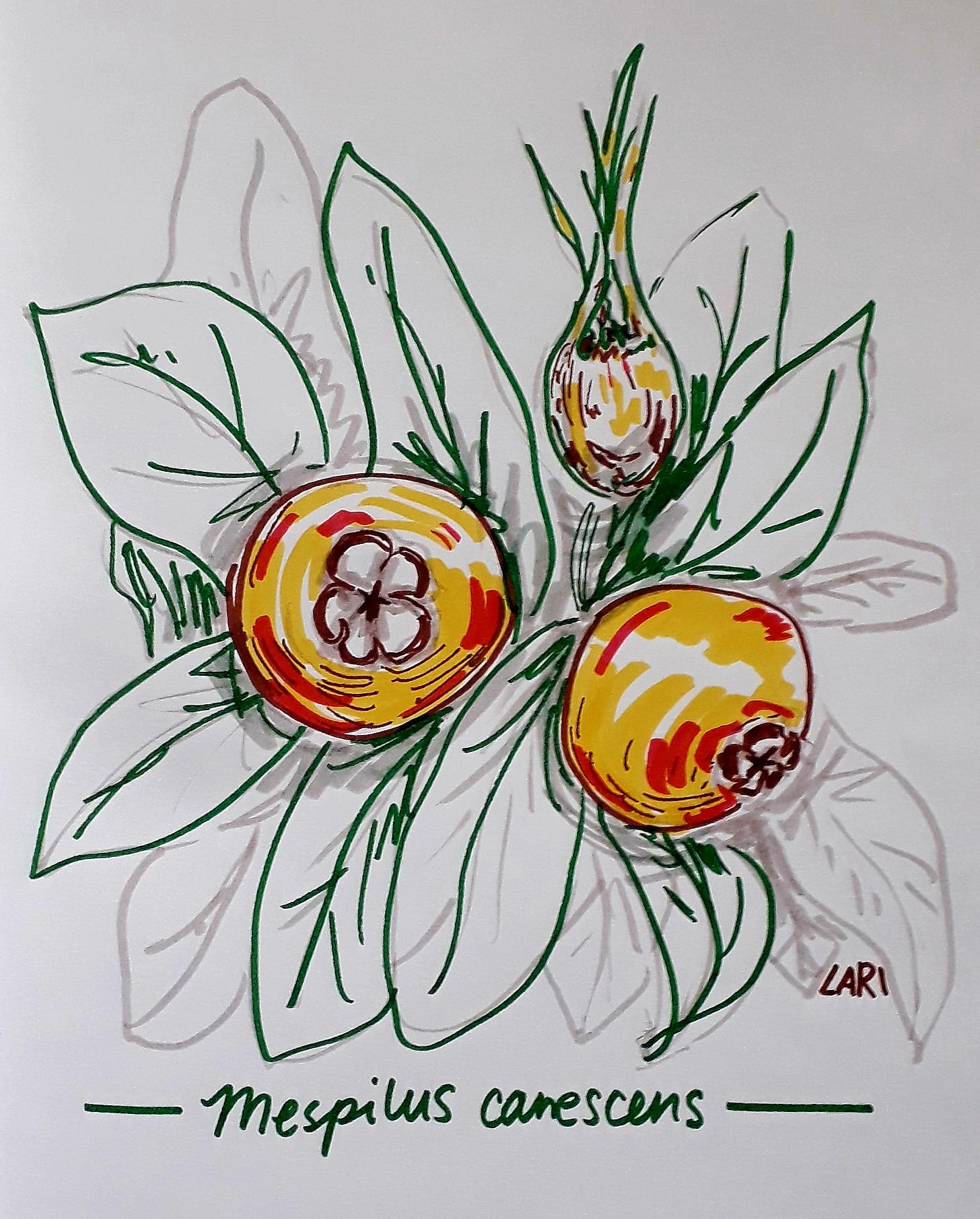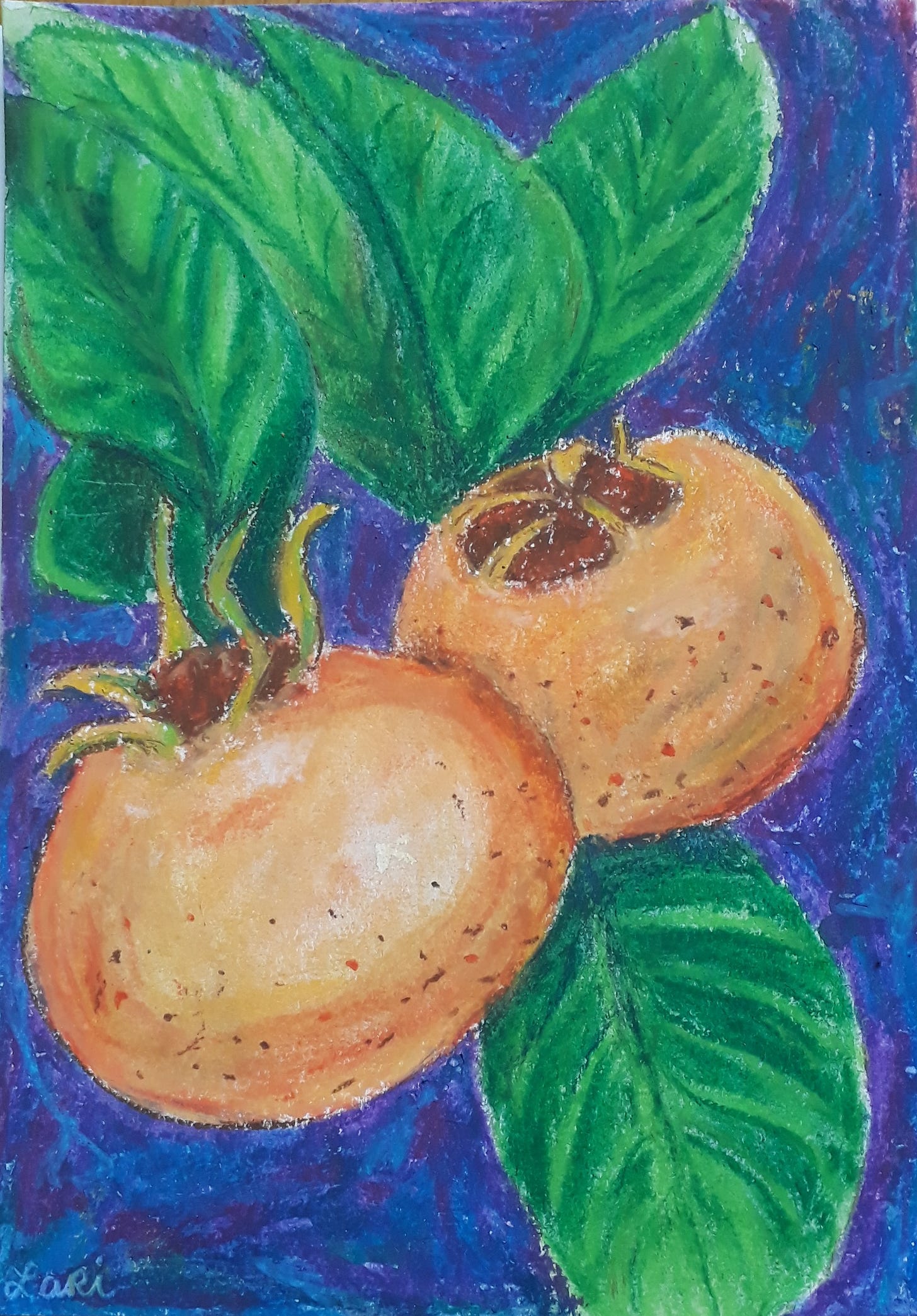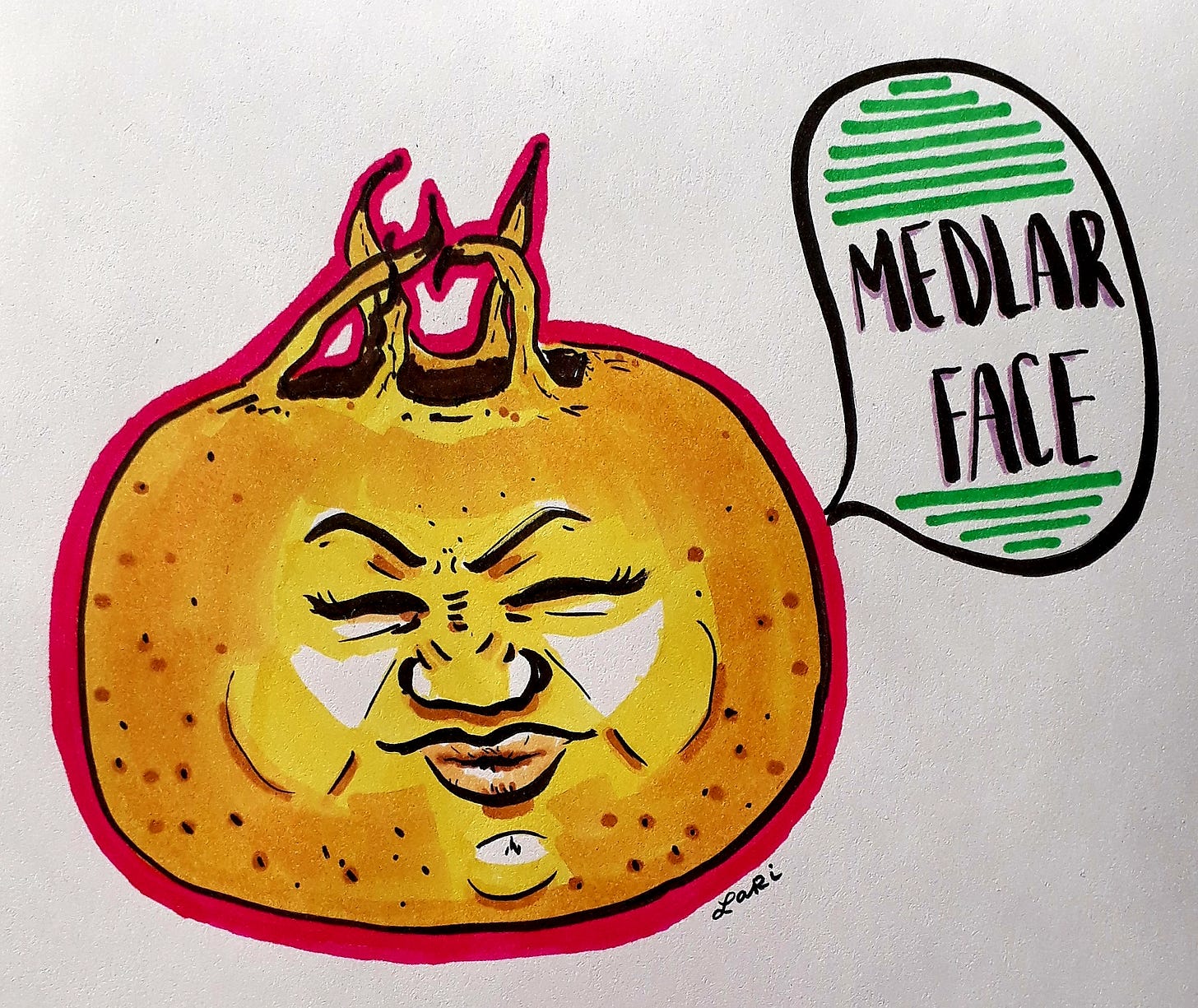Hello to all, and welcome back to RENDERED. Thanks for reading.
The medlar, a once-common fruit in parts of Western Europe, is coming back into vogue after generations of cultural forgetfulness. When reading about it in English, it is declared "forgotten," and in need of rediscovery. But in some places, the fruit has been cultivated and eaten for thousands of years, as a long-standing tradition. This begs the questions: What does it mean for something to become unfamiliar, foreign, or forgotten? How can we recontextualize it? Who do we allow to recontextualize it?
Today, I'm talking medlars (Mespilus germanica). Nèfle in French, muşmula (mushmula) in Turkish, azgil or azgel in Farsi. It's a fruit, a relative of roses, quinces, apples, and crabapples.
Its native territory includes southeastern Europe, Asia Minor, Caucasus, and in particular, the humid Caspian Sea region, including Northern Iran. It may have been domesticated in that area up to 3,000 years ago. As it is a hardy plant, it spread throughout Europe with the Greeks, then the Romans from the 2nd century BC, reaching modern-day France, Germany, Switzerland, and Britain. It can even survive as far north as Scandinavia. In 2011, archaeologists found medlar pits in an ancient Roman cesspit, at the site of a village on the banks of the Rhine in Switzerland which had been under rule of a Celtic king. The 19 medlar pits were an unusual find, proving that the tree had already been firmly established in that region by that time. (As a layperson, it's also an unusual thought to imagine digging through 2,000 year old shit, but hey, maybe that’s just me.)
Medlars are unique in that they may not be eaten when freshly picked, much like quinces. It is a hard, astringent fruit that could make you sick if eaten too soon. It must be bletted to be edible. Bletting is a process in which the medlars are collected and stored, stem side down, in straw, sawdust, or bran, and left in a humid, cool place where the enzymes in the fruit can do their magic: sugars develop, and the flesh turns very soft and brown.
The bletted fruit's flavor is described as that of baked apples, but more sour, with a hint of spice, wine, and "gentle decay." Apparently, you either like it, or you don't.
In appearance, they are round and apple-shaped, but open at the bottom, which exposes 5 seed boxes.
The medlar is a fruit that reaches its prime several weeks after it's picked, and was once the only local fruit available in the dead of winter. Because of this, it came to be a Christmas dessert in Europe, and a fixture through the medieval period, reaching its peak popularity during the 1600s.
Medlars would be baked, roasted, made into jelly, turned into alcohol, or served at the table by scooping out the flesh to mix with cream. One may also eat a medlar out of hand, though probably not in polite company. It was known familiarly as "open-arse," or "cu'-de-chien" (dog's ass), due to the suggestive appearance of the exposed seeds at the bottom of the fruit. You can also make "medlar cheese," which is not cheese at all, but medlar purée mixed with eggs and butter, similar to lemon curd. The fruit enjoyed several hundred years of popularity in Britain.
During World War II in England, people were encouraged to forage for them during food shortages. But after the 1950's, when imported fruit could be bought year-round, and the laborious process of picking and bletting medlars became unnecessary, they fell out of favor and were soon forgotten.

Today in England, medlars are grown in some private gardens as a quaint nod to times past, and some trees grow in public spaces, though they often go unrecognized. There is a small medlar producer profiled in a BBC article who is bringing back the fruit to a British audience, which is indeed a niche market.
In one paper I read about medlars, the authors enthusiastically encourage people to plant medlars and enjoy the fruit once more, insinuating that the tree should be grown more widely for its ornamental purposes, and "at the very least" because of its frequent allusions in English and European literature.
Chaucer uses the medlar (open-ers, aka. “open-arse”) as a metaphor for an old man's stamina in "The Reeve's Tale" in The Canterbury Tales:
This white top writeth myne olde yeris,
Myn herte is also mowled as myne heris,
But if I fare as dooth an open-ers,
That ilke fruyt is ever lenger the wers,
Til it be roten in mullok or in stree.
We olde men, I drede, so fare we,
Til we be roten kan we nat be rype.
This white top reveals my old years,
My heart, too, is as mouldy as my hairs,
Unless I be like medlar, all perverse.
That same fruit increasingly grows worse,
Until it's rotten in mullock or straw.
We old men, I fear, obey this law:
Until we're rotten, we cannot be ripe.
Men are apparently like medlars: they're not in their prime until they've gone rotten. Charming.
Shakespeare also mentions medlars in Romeo and Juliet with some "medlar"/"meddler" word play:
Now will he sit under a medlar-tree,
And wish his mistress were that kind of fruit
As maids call medlars when they laugh alone.
O, Romeo, that she were, O that she were
An open-arse, thou a pop'rin pear!
Bawdy jokes aside, all these factoids don't make me want to try a medlar. And while a shakespearean quip or a saucy Chaucer quote might appeal to my literary interest, I'm not European at heart, and I have to tell you, I'm not one for genuflection before European greatness. (Says the woman who married a Frenchie and moved here.) I have no interest in the resurrection of a medieval, ossified culinary anecdote about "the way things used to be." These aren't my memories.
Reading all this about the "forgotten" medlar got me thinking: to whom is it forgotten?
Who holds the living, breathing memories that center around taste and tradition?
A quick online search, followed by Instagram hashtags #muşmula and #ازگیل (azgil) show that in other regions of the world, it's far from uncommon, and certainly not forgotten.
I came upon a Turkish-Canadian blogger who has eaten medlars all her life, describing mushmula as an "acquired" taste, like eating the sour flesh of a fruit that is more of a paste, while being mindful of the five large pits it contains. She mentions that in Turkish, calling someone "medlar-faced" means that they have a permanently sour expression.
I also had the pleasure to exchange with Nastaran Nourbakhsh Kaashki, with whom I became acquainted via a friend's friend. Nastaran is from Northern Iran, where the plant thrives, and was kind enough to answer my questions.
In Farsi, the fruit goes by azgil or azgel, and in Gilaki, the language of the Gilan region, it is called koonoos. When the azgil is ripe, it is as soft as blueberries, tasting sour/sweet. Some people pickle them in vinegar as a condiment. Others make azgil paste, which features in the recipe for a local type of bread.
In one video Nastaran sent to me, rural people shook the branches to collect the fruits, and cooked them down into a paste. A crushed-up green herb was added to the pot--likely to be blue eryngo, or flat sea holly, as it's an herb that is often used in Northern Iranian cooking. The result is a thick, glossy, luscious-looking red syrup that gets bottled up. Another video shows a festival in Amol, a city in Northern Iran, where azgil paste is being made and sold to festivalgoers.
From this one conversation, it is easy to tell how ingrained this fruit is in the region where it originates. After seeing how it's prepared and eaten, and described by people who've eaten the fruit themselves, I am inclined to try it. If I have the luck to come across a medlar, I would love to give it a taste.
In examining the medlar, I've been asking myself: How do I judge something based on how it is presented to me? How much do we rely on Euro-centric references to contextualize that which is "unfamiliar," "novel," or "exotic"? What can be gained from the attempt to contextualize it?
While I think that we could spend many years considering these questions, ultimately I think the answers depend on who we talk to, and how we listen.
Many thanks to Nastaran Nourbakhsh Kaashki for her help and insight.
Thanks very much for reading. If you enjoyed this essay, please don’t forget to like and comment, and if you’d like, share it with a friend. I'll be back on May 1st for the second installment of TIDBITS (my narrated essay series, available to paying subscribers only), and May 14th for the next illustrated food history essay. Until then, take care.
Bibliography
John R. Baird, and John W. Thieret. “The Medlar (Mespilus Germanica, Rosaceae) from Antiquity to Obscurity.” Economic Botany, vol. 43, no. 3, 1989, pp. 328–372. JSTOR, www.jstor.org/stable/4255177. Accessed 4 Apr. 2021.
Davidson, Alan and Tom Jaine, ed. The Oxford Companion to Food, 3rd ed. Oxford: Oxford University Press, 2014.
Enzenbacher, Tiffany. “A Medlar by Any Other Name.” Arnoldia, vol. 77, no. 1, 2019, pp. 16–25. JSTOR, www.jstor.org/stable/26866491. Accessed 10 Apr. 2021.
Gorvett, Zaria. "The forgotten medieval fruit with a vulgar name." BBC. 25 March 2021.
Karp, David. "Exotic Taste of the Past." Los Angeles Times. 16 December 2010.
Karp, David. "When 'Fresh' Isn't a Selling Point." New York Times. 3 November 2004.
McGee, Harold. On Food and Cooking: The Science and Lore of the Kitchen. New York: Scribner, 2004.
"Medlar." Britannica.com.
"Muşmula." Nature of My Memories. 14 December 2015.






A great piece on ‘medlars’ which I had no idea were even called that in English. But I know the tree well because I have one in my small city garden in France. I decided to get one simply because of its delicate white flowers in spring and also because it stays relatively small. I have always just ignored the strange-looking fruit, letting it drop to the ground in winter. But after reading your article I may have to try one.....one day 😊
Never heard of medlars before. Enjoyed bawdy reference and men not mature until they are rotten. I better make sure they are ripe rotten before eating!💛